#he wanted to give up all his worldly possessions and go on a pilgrimage to india
Text
hearing about fully adult age difference discourse cracks me up for the very specific reason that when i was 24 i dated someone who was literally twice my age. now, this wasn't ultimately a great idea because it turns out people in different phases of life often want different things, and we ended up breaking up after my parents came to visit and i felt like i should sit at the kids' table, but before that. we got a few slightly-concerned jokes from people, you know, less of the "isn't that a little predatory" thing you'd see on tumblr and more "lol are you a gold-digger for older men" (my guy was living in a studio above the grocery store), but in both cases, no. no, we were actually both morons who each thought the other was in their mid-30s and didn't bother to check until we were like two months in and i said "let's do something fun for my 25th birthday!" and he was like "i'm sorry WHAT" and i said "what?" and he said "i'm turning 50 next month" so anyway,
#i ran out of story that's all there is#he wanted to give up all his worldly possessions and go on a pilgrimage to india#i was like actually i have no worldly possessions to give up yet and i would like to get some#we parted amicably. he was super nice and referred me to another job when i got laid off#it took me 20 minutes just now to remember his name
86 notes
·
View notes
Text
Yin & Yang- A realistic story of Zutara & Kataang
Okay, so after obsessing over ATLA and my true OTP Zutara, I’ve went away to plan out how things could have panned out (yes it’s 2020 and yes, I should be over this by now). This INCLUDES a Kataang relationship, as I do think that they would have given it a shot, but, as we all know, not everything in your teens works out.
I also figured out how to give Aang a child so that the air nation could be continued through his lineage.
Hope you like it (fyi, this is written in note form rather than full-sentence-fanfiction. Don’t hate me)
Enjoy my obsessiveness :)
_____________________________________________________
Zutara Head Canon:
• Kataang post war- Help to get things back to normal across all nations with team Avatar and enjoy many adventures together as a couple. Later, they leave to travel together for 2 years as a couple. They enjoy all their firsts together- first kiss, first ‘I love you’, first ‘time’ together etc.
• Katara finds herself pregnant at 20
—————————————————
• They move to a deserted Air temple island to live together
• After birth of baby Tenzin, Aang’s avatar duties continue to become evermore pressing. Katara is increasingly left alone on air temple island with baby Tenzin.
• After over a year in the current situation Katara and Aang both share their concerns:
Katara: -Hates being alone
- Misses her family
- Air Temple island means nothing to her
- Maybe did this all too quickly
- Tenzin hasn’t even met his Grandparents yet
Aang: - Underestimated his role as Avatar after beating Sozin. He needs to be all over the kingdoms for his work
- Hates seeing Katara unhappy. It’s the last thing he wants. He wants to support her in anything that would make her feel better
- In the long term, the future of the air nation is important to him
- Maybe they were a bit young to settle down like this, with so much going on with their life still
• They both agree it’s best for all parties for them to split amicably. Katara moves back to the Southern Water Tribe to be around family, Aang goes with her for the move, and stays a while to see them settle.
——————————————————
• Katara spends a few years in the southern water tribe. She often see’s Sokka and Suki when they return from their own lives. She grows close to Suki as she updates her of the lives of others in the other kingdoms.
- Toph and Uncle Iroh live in the earth kingdom. They have become close (to Zuko’s jealousy) and Toph see’s him as a parent, he, her as a daughter
- Mai broke up with Zuko 2 years ago, she became overwhelmed with the life and pressures of a ‘to-be-fire lady’ she was never the type of girl to be ordered about, constrained and smile for the pleasure of others. Since then he has only had short flings with beautiful fire nation women who happen to stumble around the palace - This has caused strain on Suki’s relationship with Sokka, as often when Zuko and Sokka are together, Sokka seems to get involved with these ‘ladies’ as well. Katara can often sense when they are around, when they are fighting, always over the same thing-Sokka’s behaviour in the Fire Nation with Zuko. She tries to reason with him, make him appreciate Suki; often it’s too late and Suki deploys herself to some mission with the Kirosi warriors, not to be seen again in months. She is not one to sit around and be walked over. However, most times when she returns, they kiss and make up.
• While living with the southern water tribe they find Tenzin is an airbender. Aang is thrilled and can’t contain his excitement, however, Tenzin is still too young to go through any proper training, Katara protests.
• Katara’s father and family LOVE Aang- he fits perfectly
• Aang often updates Katara on all that is happening- he is working closely with Zuko on the plans for Republic City, rebuilding of the earth kingdom and plans for the air nation and the breeding of flying bison (rumours that there may be a few bison spotted in the mountains of the old air kingdom and Aang is following these)
• Katara over the years has become a southern water tribe political representative and plans to work closely with them with to reconnect with the other nations
———————————————————
• Katara (26) Aang (24) Tenzin (5)- Katara decides to make the move to the fire kingdom for work where the main plans about republic city and the reunification of the water nations are happening.
• Aang is thrilled as much of his time is spent flying between the south pole and fire nation. This means he can spend even more time with them. He even insists for them to live with him in the small home he has in the fire nation.
• The move goes well and Katatra’s work really takes off. Aang still is needed in many places but they get to spend a lot more time as a family. Katara gets to see much more of extended team avatar
—————————————————————
• On Tenzin’s 6th birthday Aang makes a very special request. He would like to start Tenzin’s airbending and spiritual training. We wants to take him with him to find the bisons. This will be a year long trip with limited contact.
• Katara is hesitant, however, does understand the need for his airbending training to start (especially since his untrained bending is smashing a lot of her stuff), she also has a lot going on at work and would love Aang and Tenzin to spend some long 1on1 time together.
• On the day they leave Katara has packed ‘the kitchen sink’ for Tenzin. “I think you may have forgotten the concept of a monk” Aang jokes nervously, knowing he cannot possibly take all of this with him on a pilgrimage. They settle on halving it and he promises to contact her as soon as they make to the earth kingdom. She sends him with some rare herbs and ice stones from the south that she insists he must get to Iroh and Toph. Aang makes her promise to look out for Zuko as he’s worried about him.
————————————————————
• Katara keeps her promise and after a meeting one day stops Zuko for a chat. He invites her out to dinner to catch up later that evening at one of the top restaurants in the fire nation.
• When Katara arrives, she is told the table is not ready and to wait for the Fire Lord’s arrival. She waits another 40 mins, only to find Zuko sat at the table with 2 very young, very pretty fire ladies. She bursts into the curtained room. “If you invite me somewhere Zuko, HOW DARE you have me waiting while to drool over some eye candy!” she shouts and storms off. Zuko tries to chase her but cannot exit without making quite a commotion as fire lord.
• The next day he stops while she’s leaving a meeting and apologises. He suggests reorganising the dinner. Katara declines and says she will make the plans this time. Dinner at her house, not some swanky restaurant.
• Zuko arrives (by carriage) and is shocked by Aang’s small home “he’s the avatar, isn’t he? what’ happened?” “he’s a Monk Zuko, worldly possessions don’t matter to him”
• Katara updates Zuko on her time with Tenzin on air temple island. Zuko tell her about finding his mother. Azula. He says he hasn’t had a home cooked meal in 3 years. He likes it
• Over the months Zuko comes for dinner, once a week, then twice, then most nights. They learn everything about each other. They laugh, catch up. She convinces him to choose 1 girlfriend and try to make it work. One time that fire lady comes to meet Katara. Sokka finds it weird when he comes to visit and Zuko walks in for dinner. He jokes how weird this will be when Aang returns. They both awkwardly laugh.
• After 5 months pass, Zuko suggests dinner at the palace- he will cook. He struggles. The food is bad, Katara tries to hide it. Zuko is frustrated
• He takes her to the turtle-duck pond and explains he has ended things with his girlfriend as his heart lies with someone else. He moves in to kiss her and she pulls away “I don’t know how I feel about this Zuko? With Aang, and you and-” Katara backs away and leaves in a hurry.
• She disappears and goes to visit Toph. Toph has just found out she is pregnant, and the father left after finding out. Toph is in a state. She hates the idea of being pregnant. She hates the idea of giving birth. She doesn’t like the idea of a restriction on her life. She hates the father. She cries to Katara “I just wish I had the chance to really love someone and have them love me back”.
• Katara leaves for the fire nation the next day. She rushes to the palace, through the guards, into Zuko’s office and kisses him. “I think I love you Zuko” she cries “I know I do” Zuko replies and pulls her in.
————————————————————
• Zuko suggests Katara to go with him to the earth kingdom later that week on his trip to see Uncle Iroh. Katara agrees (she probably needs to explain to Toph why she bailed on her) Katara spends the week worrying about pretty much everything from what she’s going to wear to whether this relationship is viable.
• Zuko picks her up and they travel- things have unusually become awkward between them.
• When they arrive at Uncle Iroh’s he is happy to see Katara. He tells her all about when Aang and Tenzin stopped to see him over their first cup of tea. Zuko smiles at the sight of Katara lighting up at the sound of her son
• In the evening Zuko stumbles around Katara. He struggles to be his usual smooth self. They sit on the porch and Katara surprises him by taking his hand. He burns her out of shock. She runs around looking for water. Iroh sees it all.
• When Katara is asleep Iroh talks to Zuko. He can see what is happening. He advises him to relax. The pressure that he is under is all in his head. They plan something special together.
• Katara goes to see Toph the next day. Explains to her why she left. Explains what is happening between her and Zuko. Toph laughs uncontrollably. She tells her Zuko’s heartbeat always used to race when she was around.
• Katara goes back to the Jasmine Dragon in the evening to find the tea shop dripping in candles and totally transformed. Zuko is sat in the middle with a plate of dumplings (Iroh made) they confront their worries and express their love. They kiss- no fire this time.
————————————————
• Over the next few months they grow together. Zuko helps Katara move into a new place. Katara studies the art of healing, Zuko if gifted a dragon’s egg, he incubates it for months and firebends it to keep warm, Zuko continues to try and pass off his chef’s cooking as his own, Katara laughs.
————————————————————————
• As summer returns once again, Katara prepares for Aang and Tenzin’s return. There is also a huge festival in town to celebrate summer’s Longer Days. Everyone is headed to the fire nation to celebrate.
• When Aang returns Tenzin (7) had grown so tall. He wears monk robes and has beads in his hair, however, Katara is relieved he is just as excitable and energetic as he was before, though, he does take mediations 4 times a day very seriously. He has sworn off meat and politely turns down the traditional southern tribe meal she has prepared for some chili bread instead. He and Aang talk in an impenetrable rhythm and Katara loves to hear them dance around each other about their travels.
• Aang is called to the Palace for a seeing with Zuko. Zuko is very nervous and Aang can tell. They talk business a short while. He thanks Zuko for moving Katara and looking out for her. “She’s so much more happy lately” “Well that’s because of you and Tenzin returning” Zuko panics “No, even when we wrote to her while we were away; I expected her to be panicked, manic even! You know her. But she was so supportive and I could really feel like she was putting herself first for once”
Zuko takes him to see his dragon egg. Zuko is nervous and every time he begin to open up about what has happened over his time away he trips over his words, looses his confidence or beings smoking out his ears.
Aang senses his tenseness and drags him outside excitedly- this is a perfect chance to show his friend the new meditation techniques he’s learnt on his travels. They sit across from each other on the grass cross-legged. Aang gets him into a state of serenity and openness and the words begin to fall from Zuko’s mouth. “If you want to kill me, I understand. Some would duel, an Agni Kai, banishment? However you want to deal with me, I just want you to know I respect you and your decision, whatever it may be, and I truly love Katara” Zuko bows at the feet of Aang (something a fire lord would never be seen to do).
“This is………..WILD!” Aang springs up. Zuko peers up slightly from his stance. “I mean this is crazy! You two together, I mean I really should have seen this coming” he chats to himself “So this means you are…?” Zuko asks. Aang lifts Zuko up to his feet. “You make each other happy. I can see it. And I’m happy for you” Zuko uncharacteristically pulls Aang in for a tight hug and Aang can feel him warming up. “Zuko. You can let go know” Aang squeaks after a few too many moments pass. Zuko quickly lets go and clears his throat “erm, yeah. Thanks man” he casually shakes out when wiping away a tear.
——————————————————————
• 2 years pass. Zuko continues to come for dinners and stay the night, this time with Tenzin around and often Aang is a welcome guest. Aang and Tenzin are inseparable, and they raise their newly born bison together. When Aang leaves for his duties Tenzin cries but is comforted by his favourite gifts from his Uncle Zuko- a blanket, dream catcher, and stuffed toy bison. He also shows him cool fire tricks and helps with his training. Zuko’s dragon finally hatches, he names it Heti and becomes overly maternal to it. Its heart-warming for Katara to see him in a parental light and confirm to her, a future with him is possible.
• One summer, while Aang is away, Zuko takes Katara and Tenzin to Ember Island for a rare holiday. Tenzin plays in the sand and creates mischievous sand tornadoes. Katara water bends waves and teaches Zuko to surf, Zuko host bonfires in the evening and fights with Katara to tell stories of their adventures to Tenzin. He loves them.
Katara (28) Aang (26) Zuko (29) Tenzin (9)
· Zuko proposes on he and Katara’s first trip to the Southern Water tribe. They planned to go to introduce him properly to her people. Zuko was reluctant to leave Heti behind as he is too young to be in such cold, however, feels assured that he left him with Aang to take care of. (Tenzin is also there, and he and Heti get on like a house on fire). When he arrives he can barely stand the cold and finds it weird to sleep all together in huts rather than the large separate rooms he grew up in. Katara’s father teaches him to fish, he listens to the issues of the community as fire lord, he races Sokka on the wolves. He eats traditional food and tracks the stars. One night, when the moon is at it’s fullest Zuko gets down on one knee and proposes to Katara with a green emerald ring. When she accepts, he releases fire-bent fireworks from his palms and they watch awe (he tell her how he has been trying to perfect this technique for months for this very moment) “it’s perfect” she whispers.
· Zuko and Katara get married 8 months later. A small ceremony on Ember Island with their close ones. Iroh officiates, Sokka cries, Aang grins, Toph whoops. They dance on the beach and partake in a special tea ceremony.
Katara’s coronation as Fire Lady is much larger. It’s in the fire nation, thousands gather, Zuko has never seen her so beautiful-he is shocked. She moves into the palace and he finally has someone to share his large bed with. Tenzin hides from his tutor in the palace, however, when he’s around, Zuko seems to always know the spots where he is hiding. Aang decides to fully become a monk and swears off his home, possessions, romantic relationships and money. Katara’s marriage and role as fire lady finally unifies the fire and water nations and installs confidence into the water tribes.
----------------------------------------------------
· In Katara’s first pregnancy, Zuko is overprotective and nervous. He never seems to catch the baby kicking. He paces for hours when Katara is in labour. It scares him when he hears her screams and, breaking tradition, he runs in to comfort her. They have a Son- Iroh II - a firebender.
· On her second pregnancy a year and a half later the opposite happens, the baby kicks all night and Zuko always feels it. Katara is exhausted most of the time and feels bigger than a whale. She waddles around the garden most days with Zuko and Heti by her side. She gives birth in what feels like seconds, on the floor of Zuko’s study. It turns out to be twins- A boy, Roku (Waterbender), and a Girl, Zaya (Firebender).
· Katara’s 3rd pregnancy is quite a few years later and quite a surprise to Zuko. It is in the winter and Zuko spends most nights keeping his wife and baby warm. Roku is the only one who seems to make the baby kick. They baby is 2 weeks late. Zuko tries everything to try and get Katrara onto labour, hot chillies, water therapy, even a very bad song, which doesn’t start labour, but makes Katara laugh. She never lets him forget it, to his embarrassment. They finally have a girl, a waterbender named Kya.
----------------------------------------------------------
· As Tenzin grows, he goes on more trips with his father, then pilgrimages of his own. He balances out into quite the soothing personality. When he is home the children seem to calm down and listen to him more than anyone- to Zuko’s delight. He gives them all lessons in mediation and control of their bending. He wrestles with the twins, feeds the baby and practices duelling with Iroh. Most of all he lays and trains with Heti- he seems to have a way with animals.
· Iroh is smart and dedicated to mastering bending. He and Tenzin often disappear and return days later having learnt and, quite dangerously, trying out new styles they have read- these often end up with someone getting hurt or something in the house brunt or smashed. Katara is constantly chasing them to stop. Zuko watches them, takes notes and tries it himself late at night while no one is around (lol).
· The twins are the loudest and are always at odds. They embody the yin and yang-ness of fire and water and each other. Unlike their parents, they have not found the point of balance between the two. They only time they seem to get along is when they are up to mischief, which is the only thing they seem to agree on. Ruko is confident with bending, Zaya is scared of hers, it takes her much longer to bend. She often trains with Uncle Aang to teach her not to fear fire and how to bend it.
· Kya is cheeky and a daddy’s girl. Often Zuko can be found late at night having worked late with a sleeping Kya on his chest, both snoring. She seems to be able find water anywhere and someone in the palace can always find her in a wet mess.
---------------------------------------------------------------
· Tenzin continues his father’s mission through is life to resurrect the air nation with his own wife and children. He also finds and nurtures the first heard of Bison the world has seen in a century.
· Iroh goes onto become a master firebender. He works to write down the art of firebending and at the age of 42 becomes Fire Lord.
· The twins in their youth go on to become to become pro-benders and compete as a team- to their fathers distain- it is unbecoming as prince and princess. As they mature, Roku travels the world and Zaya goes on to become a general in the army
· Kya as an adult moves to the southern water tribe permanently to live with the water benders as a healer.
· Katara and Zuko live a long life together. Katara finds her job as Fire Lady challenging and uncomfortable at times and argues with Zuko and the council about tradition. Zuko becomes an honourworthy Fire Lord and is respected by all. They together are remembered as the shining example of cooperation and love for all opposites and nations.
-----------------------------FIN-------------------------------
[Forgive me for having any age gaps or locations wrong]
#ATLA#Zutara#kataang#steambabies#katara#zuko#aang#sokka#toph#suki#sokka x suki#zutara month#fanfiction#head canon#zuko x katara#headcanon#avatar#avatar the last airbender
417 notes
·
View notes
Text

This post is based on my knowledge of traditions of the north and center mainland of Greece. However, I am pretty sure most of those things apply to Greek Orthodox people universally. Needless to say, each village and town can has its own local traditions when it comes to religious occasions.
I am a Greek Orthodox living in Greece, raised into the religion.
I will translate some phrases directly, hoping to give a more “raw” meaning.
If you are not sure you understood about certain information in the post, feel free to ask me on Tumblr!
Google Drive Link for the post in .docx format
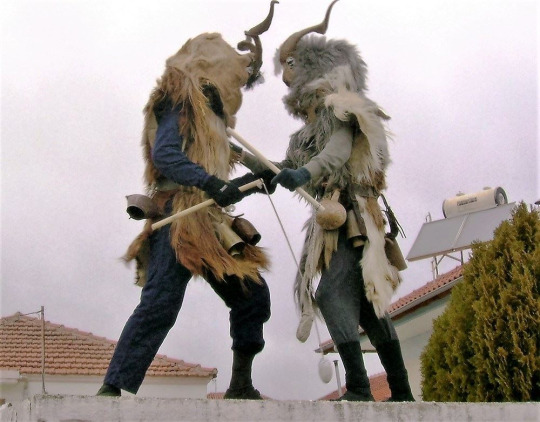
Table of Contents
Philosophy.
The Church as a building and as a center of faith.
Chapels and even smaller churches.
The Communion.
Livanisma / Thimiama – Incense burning.
Home Altars.
Clothing.
Komboskini - The prayer rope.
Tama - Votive
Crosses in high places.
Wedding
Baptism
Wedding & Baptism.
Burial customs and honoring the dead.
Agiasmos - Blessing.
Protomaya.
Martis - The protective bracelet of Spring.
Easter Traditions.
Vasilopita on Christmas
Kalanda
Mount Athos
Pilgrimage to Tinos
The Catching of the Cross
More customs
Random Information
1. Philosophy
Love and Forgiveness are the main pillars of the faith. Some people follow the Bible to the letter, others pick the parts that think reflect our age and most of people keep the general message of the teachings. The Holy Texts are interpreted differently by different people and there can be contradictions in lifestyles and believes. However, the notion that having love and forgiving is what makes you a Christian is widely believed.
Anyone who does not love does not know God, because God is love. - 1 John 4:8
Love is patient, love is kind. It does not envy, it does not boast, it is not proud. It does not dishonor others, it is not self-seeking, it is not easily angered, it keeps no record of wrongs.- 1 Corinthians 13:4-5
There is no fear in love, but perfect love casts out fear. For fear has to do with punishment, and whoever fears has not been perfected in love. - 1 John 4:18
Don’t say ‘I am hated, and that’s why I do not love‘. For this is why you out to love the most. - Ioannis Chrysostomos
“But I say to you who hear, Love your enemies, do good to those who hate you” Luke 6:27
“Do not judge, and you will not be judged. Do not condemn, and you will not be condemned. Forgive, and you will be forgiven.” - Luke 6:37
"Then Peter came to Jesus and asked, 'Lord, how many times shall I forgive my brother or sister who sins against me? Up to seven times?' Jesus answered, 'I tell you, not seven times, but seventy-seven times.' " - Matthew 18:21-22
2. The Church as a building and as a center of faith
Jesus and the Apostles gave us some directions for the worship but most of practices, as well as the architecture of worship came from the Greeks themselves. I jokingly say that Greeks are low key pagans, because religion didn't change the culture. (It did, but only a bit).
Christians first worshipped inside the old temples of the Hellenic gods (the Parthenon was once the temple of Virgin Mary) and they built their first churches in that style. The architecture changed with time but it still carries the mark of ancient temples.
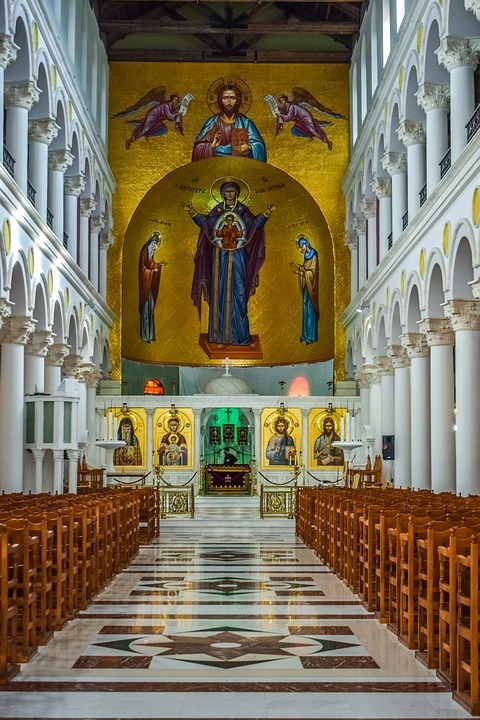
Agios Demetrios Thessalonikis
In this link you can view the different styles of architecture for Greek Orthodox Churches. (Link)
In Orthodox churches you don't have to have a feeling of the dominance of God, like in the Catholic or protestant churches, but a feeling of warmth and belonging.
In the hall you can buy a candle to light on a display of candles in the hall, to get a blessing for yourself and the soul of anyone you want. Nobody supervises you there.


You can also not pay but I haven't seen anyone not giving money, so far.
After that you kiss all the icons displayed in the hall and cross yourself.
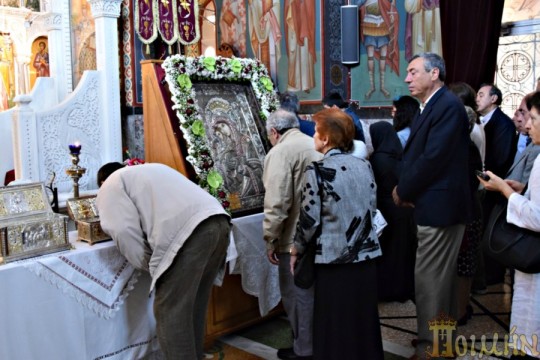
As you enter church, men on the left side, women on the right. There is also a special place for women, an interior balcony which is really cool and women go there if they want to. Nowadays man and women can go there.

3. Chapels and even smaller churches
Chapels serve the same purpose as churches but liturgies rarely happen in them. You can get married in them sometimes.
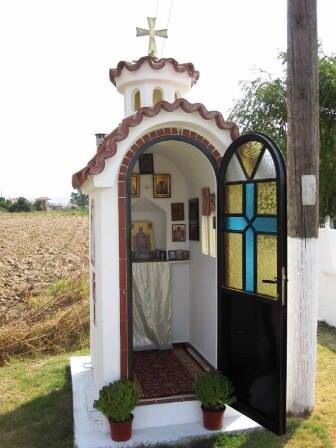
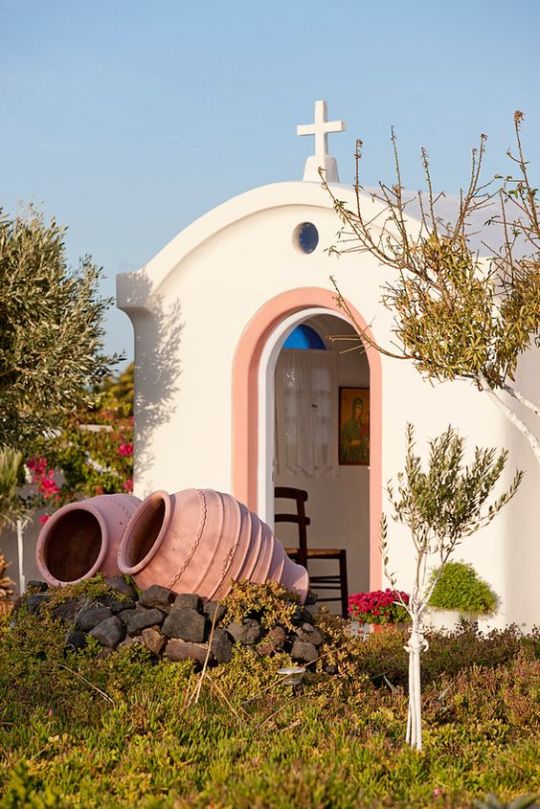
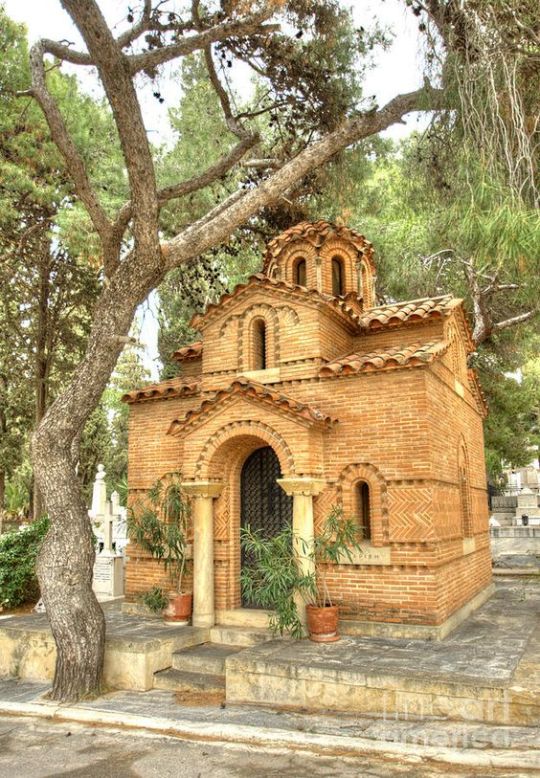
They can be carved in stone or into a cave - even in a tree or in between multiple trees.

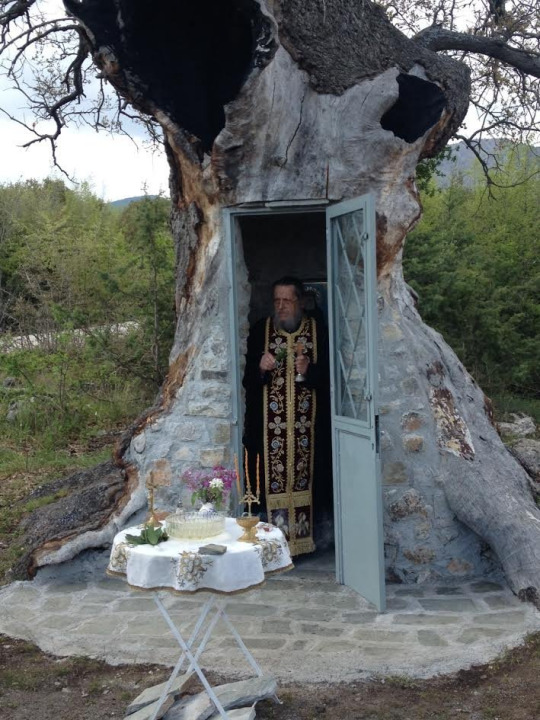


The also exist in big hospitals to bless the patients and invite people to pray for their sick.
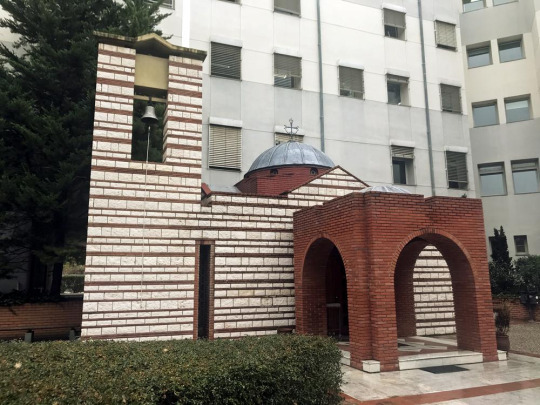

They can be seen in some big hotels, too!
But the churches can become even smaller!

Traveling the roads of Greece you will see dollhouse-sized roadside chapels. Some are elaborate little things made of terracotta or even marble, plonked in the middle of nowhere, high up in the mountains; no village or houses for miles, and yet impossibly, most of them are faithfully maintained with a candle always burning inside.
There’s a number of reasons for these heartfelt shrines, some as old as the roads themselves. Placed by the roadside, an initial assumption is that they’re built to remember a victim of a traffic accident victim, and sometimes this is exactly the case. But just as often, shrines will be built by survivors of accidents, thanking a saint at the location of their ordeal.
They can be found in home yards of people who want to come closer to God
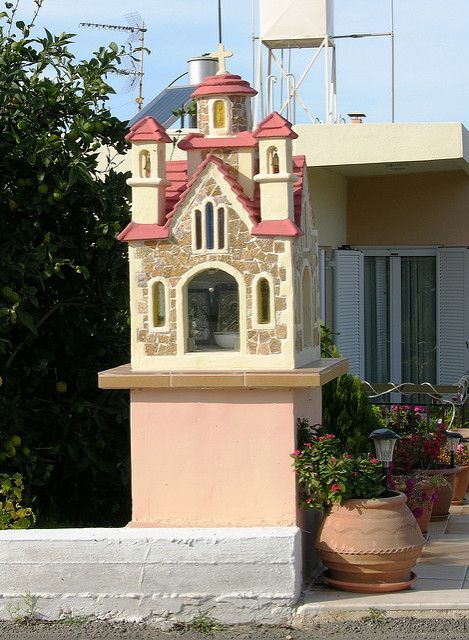
4. The Communion
We all take part in Communion with the same spoon. The Communion has bread crumbs in. Even babies drink a tiny bit of the wine (blood of Christ). Traditionally you were "unpure" if you had your period - others believed the blood of Christ would come out of you as period blood if you drunk it, so generally getting the communion during your period is a no for many.

5. Livanisma / Thimiama – Incense burning

Today, Orthodox Christians use incense throughout the church services. The priest “censes” certain areas at certain parts of the liturgy. The incense is placed inside a device known as a “censor”, which is fairly ornate in appearance and has bells on it so that we not only smell the fragrance, but hear the jingling sound as the priest uses it. This action is meant to remind us that are prayers are rising to the heavens to be heard by God.

Typically in the Orthodox Church, dried incense cones are used. In order to provide the heat needed to allow the cones to burn, a special type of charcoal is used. You also may burn resin, such as Frankincense or Myrrh, directly in an incense burner using charcoal without taking the extra step of mixing it with a binding agent.
Churches often get their incense from special suppliers and maybe even monasteries where the monks or nuns make their own. Typical scents that are used include Frankincense, Myrrh, and Rose.
The believers can also burn incense in their homes and say prayers to ward of Evil.
6. Home Altars
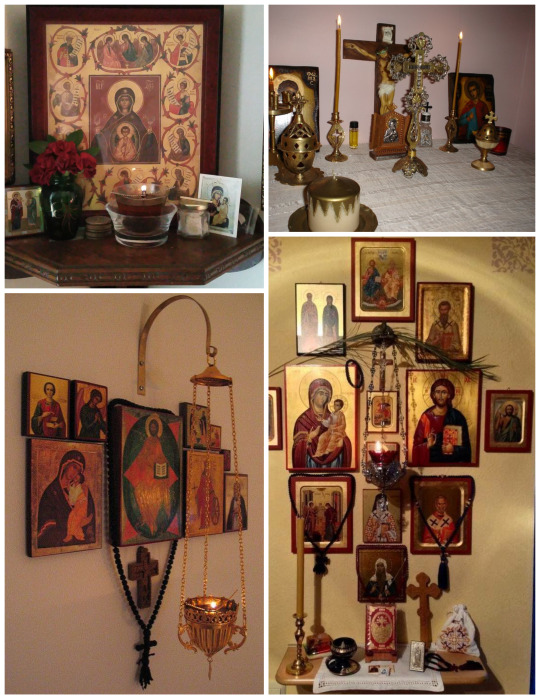
An Orthodox Christian is expected to pray (to be connected with God) constantly. According to Bishop Kallistos Ware, "In Orthodox spirituality, [there is] no separation between liturgy and private devotion." Thus the house, just like the Temple (church building), is considered to be a consecrated place, and the center of worship in the house is the icon corner.
An icon corner is normally oriented to face east. It is often located in a corner to eliminate worldly distractions and allow prayer to be more concentrated. Here is where the icons that the family owns should be located, normally including at least icons of Christ, the Virgin Mary, and the Patron Saint(s) of the family.

An oil lamp normally hangs in front of the icons. The careful trimming of the lamp to keep it burning at all times is interpreted as symbolic of the attentive daily care faithful Christians should take over their souls. Relics of saints (if the family possesses any) and a Gospel Book and a blessing cross would be kept there, as well as incense, holy water, palms and pussywillow from Palm Sunday, candles from Pascha (Easter), and other sacred items, as well as a personal Commemoration Book (containing the names of family and loved ones, both living and departed, to be remembered in prayer).
7. Clothing
People should enter the church in modest attire. No shorts and no short skirts. Women don’t need to cover their head. In fact, almost no woman under 80 covers her head in church.
With special occasions being the exception, Greek Orthodox Priests wear a black himation because of the fall of Constantinople. They wear it all the time, even to grocery shopping. They have long hair and beard.
In rare cases you will see women dressed with a long black cloth - something like a burqa but the whole face is uncovered. They are nuns or devoted to Christ.
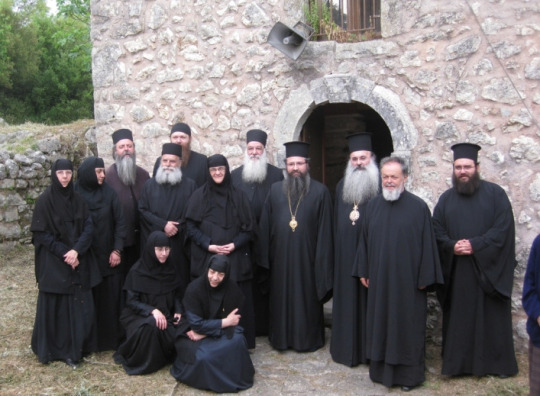
8. Komboskini - The prayer rope
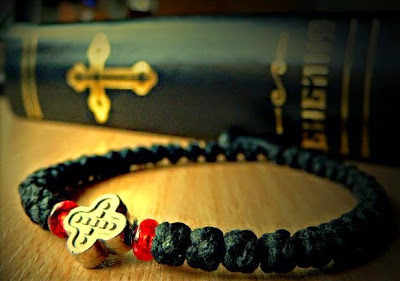
The prayer rope, known in Greek as a κομποσκίνι (komboskini), has long been a powerful weapon for the Orthodox Christian. It has a very simple design, but is filled with meaning. The rope typically comes in one of three lengths, 33 knots, 50 knots, or 100 knots, though there are some in use which are as long as 500 knots. The 33 knots of the shorter rope symbolize the 33 years Christ spent on earth.
It is used in conjunction with the Prayer of the Heart. On each knot is said, "Lord Jesus Christ, Son of God, have mercy on me, a sinner." This prayer is occasionally shortened to, "Lord Jesus Christ, have mercy on me," and other prayers are sometimes said, such as, "God be merciful to me a sinner." Prostrations can also be made with each prayer or after a certain number of prayers. By carrying a prayer rope on us discreetly, we are reminded to “pray without ceasing”.

The prayer rope is attributed to St. Pachomius (4th century). The devil would untie the simple knots he would make to count his prayers. Inspired by a vision from an angel of God, St. Pachomius was able to create a special knot composed of nine interconnected crosses (representing the nine angelic classes), that the devil was unable to untie.
9. Tama - Votive
Tama is a form of votive offering or ex-voto used in the Eastern Orthodox Churches, particularly the Greek Orthodox Church. Tamata are usually small metal plaques, which may be of base or precious metal, usually with an embossed image symbolizing the subject of prayer for which the plaque is offered.

The tradition comes from the ancient years, when Greeks offered metal or marble plaques to the gods, often for the cure of an ailment. Eyes may indicate an eye affliction, hands or legs may indicate maladies of the limbs, a pair of wedding crowns may mean a prayer for a happy marriage, etc.
Tama also means Promise. Usually the believers promise something to a saint in exchange for their help on something. My aunt made a tama to the saint Anastasia Farmakolitra ("saves through medicine") to change her name day from the day of the Resurrection to the day of Anastasia Farmakolitra's day if her daughter passed to Pharmaceutical School. Many promise to light big candles (Lambathes) as an offering to the saint or make a donation to their church. Making a lambatha in your height is a standard tama.
10. Crosses in high places
The Greeks want to feel watched over by the Divine but also leave their mark in the area they live. A way to show their devotion is to place big crosses in hills and mountains which overlook their city, town or village.
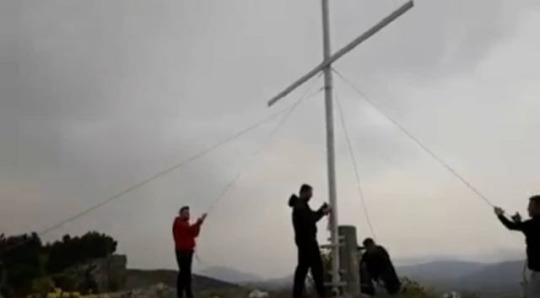
In some cases you find those crosses in high, remote places.

Some crosses light up at night!

11. Wedding
When the priest says "and the woman should fear the man" in a wedding, the bride may step on the groom's foot to show dominance.
In the bride’s shoe sole her unmarried friends write their names. The woman whose name fades first will be the first to marry
The relatives also put money into the shoe of the bride “so it can fit better“ - but really it’s just a gesture to give money to the couple
The Crowning is the highlight and focal point of the Sacrament of Holy matrimony. The priest then takes two wedding crowns (stefana), and blesses the bride and groom in the name of the Father, and the Son, and the Holy Spirit, and then places the crowns upon their heads. The Best Man or Best Woman then interchanges the crowns three times as a witness to the sealing of the union. People keep their stefana in their house and even frame them.

12. Baptism
Greeks take their names from their grandparents (since ancient years) and the name is kept a secret until the baptism.
It is a ceremonial moment because prior to the Christening, the individual is not yet part of the church family. In the church hall the priest asks the person to be christened to renounce Satan. If the individual is an infant, the godparent does it for the child. In the next major part of the ceremony, the person being baptized is immersed in the water three times, which is symbolic of Christ’s birth, death, and resurrection. The person is oiled - so they can be blessed and slip from the hands of Satan - and a tuft from their head is cut - to symbolize new beginnings, devotion to Christ and to give Satan less hair to grab them from. If baptized as an infant, after immersion the child is placed in the arms of the godparent with a white sheet, which symbolizes purity. Then, the child receives the sacrament of Chrismation.
The godparent gifts a golden cross to the baptized and, as long as the baptized is young, they buy them shoes for Christmas and an Easter Candle for Easter.

13. Wedding & Baptism
You can do a wedding-baptism to save money. First the marriage, then the baptism. If the child is about to die before a baptism gets arranged - God forbid - they get baptized in the air (and not in water) by a priest.
Koufeta (Sugar Coated Almonds) are mainly served in weddings but also when wedding and baptism happen in the same day. They are placed in little bags in odd numbers and are served on a silver tray. Odd numbers are indivisible, symbolizing how the newlyweds will share everything and remain undivided. Tradition holds that if an unmarried woman puts the almonds under her pillow, she'll dream of her future husband.
After wedding and/or baptism there is - of course - a feast with hundreds of guests.

14. Burial customs and honoring the dead
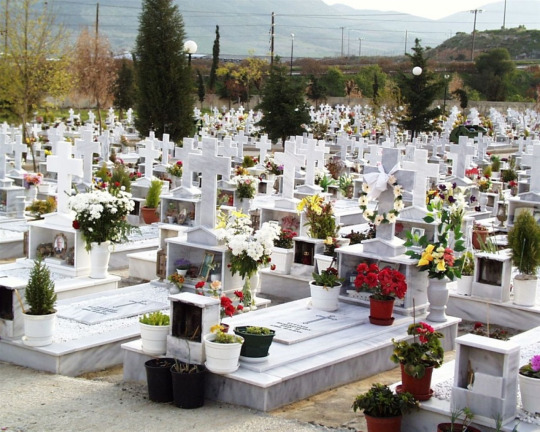
Pouring wine on the graves during the burial, as an offering or to prevent the dead from coming to life. (I am not sure but that is probably wine blessed in the church).
There is a feast after every mystery. Even funerals.There are more feasts for the dead as time passes. You have to do them in 3 days, 9 days and 40 days. You don't have to do all of them but it's showing respect to the dead and most people do them. 3 and 40 days feast are very important. For the 40 days feast - as for the funeral - there are flyers on the area, which invite people.
When 1 year and 3 years pass you go to Church and the priest mentions the name of the dead in the blessings and later comes from the grave to chant.
During the Sabbath of Souls you have to bring koliva (wheat) to offer to the dead in the family. Supposedly the dead "feed" from them. So it has to be boiled!
Charon is the one who takes souls in our recent tradition.
Graves stones often have sketched pictures or photos of the deceased on them.
15. Agiasmos - Blessing
The start of the New Year in the tradition of the Orthodox Church is marked with the blessing of homes and businesses with Holy Water, or an Agiasmos (literally, to make blessed). This practice commences immediately following the Feast of the Theophany (the annual celebration and remembrance of the Baptism of Jesus Christ – January 6). This blessing is not something done for good luck or to prevent bad luck, but rather a blessing to help strengthen and protect.
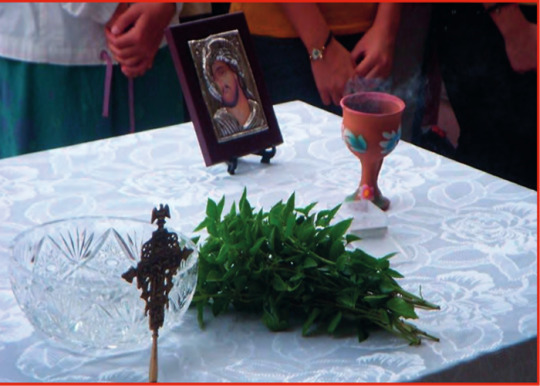
The following items are needed for the ceremony:
Small or medium size bowl, filled halfway with cold tap water
Small twig of fresh basil (floral kind)
Icon displayed behind the bowl
Hand censer, lit and burning incense during the service
The service is also provided in schools when the new school year starts. This is a particular occasion which can be annoying but also fun for the students because... water shower! Please watch this video (Link). I love it because the priest comes too close to the children - sometimes they want to bless too much - and the kids try to avoid getting wet from head to toe!
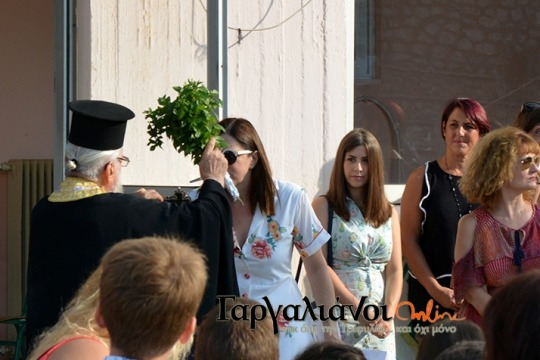
16. Protomaya
May, according to Greek folklore, has two meanings: The good and the bad, rebirth and death. The custom celebrates the final victory of the summer against winter as the victory of the life against death go back at the ancient years and accumulated at the first day of May. This day was also dedicated to the goddess of agriculture Dimitra and her daughter Persephone, who this day emerges from the under world and comes to earth. Her coming to earth from Hades marks the blooming of nature and the birth of summer.
Another ancient celebration that Protomagia has its roots is Anthestiria, a celebration in honor of Dionysos (the Greek God of theater and parties) a festival of souls, plants and flowers, celebrating the rebirth of man and nature.
The custom of May 1st is to decorate the doors of houses with flower wreaths in a way to welcome the power of nature into our home. The wreath is made from various flowers, handpicked and knitted together. In some parts of Asia Minor, people put on each wreath, except flowers, a garlic for the evil eye, a thorn to protect the house from enemies and an ear for good harvest. The wreaths adorn the doors of the houses until the day of St. John the Harvester (June 24) when all the wreaths of the neighborhood are gathered and burnt in a big fire, the fire of the saint.
See my hashtag #protomaya for more
17. Martis - The protective bracelet of Spring

It’s said it’s an ancient tradition dating back to the cults of Demeter and Persephone. Eleusis was the ancient city where the ancients performed secret rites for the cult. As a form of initiation into the cult, which was one of the Eleusinian Mysteries, the faithful wore a bracelet called a “kroki” around both their right hand and left ankle. Amazingly, the ancient tradition still lives on today in modern Greece. However, there are certain rules that one must abide by when creating and wearing the symbolic bracelet which celebrates the arrival of Spring.
Most importantly, the bracelet must be woven on the last day of February and it must be made of white and red thread. The white thread of the bracelet symbolizes purity while the red represents life and passion.
In ancient times, people believed that the bracelet helped protect the person who was wearing it from diseases, as well as the strong rays of the spring sun during the month of March. Today they say it protects from the strong rays but also the cold of March. Since it’s a transitional month you can burn from the sunrays but you also need wood for your fireplace!
Part of the ancient tradition in Greece calls for the person wearing their red and white “Martis” bracelet to take it off and tie it to the first flowering tree they see in March, in order to yield a healthy harvest and to keep the tree healthy.
Another practice with Martis bracelets occurs when the first swallow of the Spring is sighted. The first person who sees a swallow upon the bird’s return from its winter migration, ties their bracelet around the nearest rose bush to encourage the bird to make its nest there.

18. Easter Traditions
Easter is the biggest celebration of the Greek Orthodox tradition. The Holy Week, preceding Easter Sunday, is a time to ponder on Jesus’ Passion and Crucifixion. It is often regarded as an opportunity for body cleansing through fasting, visiting their town of origin and embracing local traditions.
We fast for 40 days (cutting more and more foods every week). Before the fasting we have Tsiknopempti when we eat as much meat as we want, to give our body what it needs before cutting it for 40 days. (It's sort of a celebration and people go out). University restaurants and private restaurants always have fasting options this period. The first day of the fasting is called Clean Monday and it's also like a celebration. It’s the first day we start eating “fasting” food and we also fly kites!
Kyra Sarakosti - Lady Lent

She can be made out of paper or dough. Lady Lent has seven feet. They represent the seven weeks of Lent. Each passing week, on each Saturday, children get to break off one foot. This is a great visual way to countdown the weeks until Easter.
Lady Lent has no mouth. The missing mouth symbolizes fasting. No consumption of meat, dairy products or eggs. She has no ears, this means that she refuses to listen to gossip. Her cross represents the easter religious services in the church, her hands are folded for prayer.
After the last foot is cut off, it is tradition to place this foot in a bowl with fruits and nuts and whoever finds it receives a special blessing.
You don't have to fast if you don't want to. Fasting from bad thoughts and words is equally - if not more important - than food fasting.
Epitaphios threnos (funerary lamentation) is the name of the matins of Holy Saturday, served in Good Friday evening. Within a liturgical context, this is also the name of an icon, usually made of cloth and richly embroidered, depicting the body of Christ being laid in the grave, often by the Virgin Mary and some disciples.
On Good Friday morning, the icon is placed on a platform, resembling a bier, typically topped with an elaborately carved wood canopy. In most cases, the canopy is heavily decorated with ornate flower arrangements, ribbons and sometimes candles. Young girls (the "virgins") have to adorn it with flowers.

Throughout the day, people can come into the church and venerate it. Kids have to pass under the platform in order to take a blessing.
In the evening the service begins; near the end of the ceremony, the canopied platform bearing the icon is lifted on the shoulders of priests or churchgoers (usually four to six people) and carried through the streets followed by the believers.

In towns with more than one parish, the processions starting from different churches may converge to a single spot (usually the town square), where they temporarily stop and a common hymn is sung before they resume their routes. In large towns, the chants are often performed by a marching band.
The epitaphs in the Central Square of Larissa (Short Video)
These practices have numerous variations according to regional traditions. On the island of Zakynthos in the Ionian, instead of an embroidered cloth, a lamb is used: this is a figure of the dead body of Christ, cut out from board and painted from both sides, placed vertically so that it can be seen from either side of the bier. Another famous custom, the “burning of Judas”, where an effigy of Judas is set aflame on a bonfire, is usually regarded as an Easter Sunday ritual; in some parts of Thrace and Macedonia, however, it takes place on Good Friday, after the procession. In some coastal towns, most notably on the islands of Hydra and Tinos, the men carrying the Epitaphios march right into the sea, until they are at least waist-deep in water, where they may remain for several minutes, often holding the platform high to protect it. During this time, prayers are said for the welfare and safe return of the many seafarers coming from those communities.
Watch footage from the Epitaphios procession in Kaminia, Hydra (Short Video Link)
Τhe flowers used for the adorning of the Epitaphios are considered blessed and women used to put them under their pillow for protection or to dream their future husband, or to put them in talismen for their beloved or use them as medicine, or they put them in the home altar.
On 00:01 on Easter Sunday the priests happily chant "Christ has risen from the dead!" in one of the most known and iconic chants in Greek Orthodoxy. There are fireworks and we kiss each other on the cheek having this exchange: - Christ has risen! - True!
This exchange is used by many as a greeting for 40 days after the resurrection.
In the Resurrection the priest offers the Holy Light and people go to get it and pass it to their own company or anyone else who asks for it. The candle is held in candles you buy yourself but for children their god parents buy them.
With the smoke of this fire you make a cross above your door and you don't clean it up - never. A door can have multiple black crosses above it. With the Holy Light you light up the lamps of your home altar.
Some people have breaking eggs contests right after the announcement of the Resurrection, others do them when they come home. We also eat a special soup that night called Magiritsa. It has meat so with this we cut our feast. When the morning comes we host family gatherings and eat as much meat as we want.
19. Vasilopita on Christmas

The Greek word Vasilopita is directly translated as “Sweet Bread of Basil”. When the Vasilopita is prepared, a coin is baked into the ingredients. When the observance begins, usually on New Years Day, the bread is traditionally cut by the senior member of the family, and the individual who receives the portion of the Pita which contains the coin is considered Blessed for the New Year.
Vasilopita is also cut in educational institues and the workplace. Whoever finds the coin usually receives a gift.
This age old tradition commenced in the fourth century, when Saint Basil the Great, who was a bishop, wanted to distribute money to the poor in his Diocese. He wanted to preserve their dignity, so as not to look like charity, he commissioned some women to bake sweetened bread, in which he arranged to place gold coins. Thus the families in cutting the bread to nourish themselves, were pleasantly surprised to find the coins.
20. Kalanda

Caroling (kalanda) has roots in ancient Greece. Children would carry small boats and sing songs honoring Dionysius. In Ancient Greece the children would praise the head of the household. At this time in history they would also gift the head of the household with an olive branch, which signified prosperity. Greek Christmas carols date back to the Byzantine times.
After singing for the household, the children receive money (and sometimes sweets). Before the financial crisis one could gather hundreds of euros from Kalanda.
Children say Kalanda on Christmas Eve, on New Years Eve, on Epiphany Even and Lazaros Sabbath. The songs are different for those four occasions.
21. Mount Athos
Mount Athos is a mountain and peninsula in northeastern Greece and an important centre of Eastern Orthodox monasticism. It is governed as an autonomous polity within the Hellenic Republic. Mount Athos is home to 20 monasteries. It’s commonly referred to as Agion Oros (Άγιον Όρος, 'Holy Mountain').

According to the Athonite tradition, the Virgin Mary was sailing accompanied by St John the Evangelist from Joppa to Cyprus to visit Lazarus. When the ship was blown off course to then-pagan Athos, it was forced to anchor near the port of Klement, close to the present monastery of Iviron. The Virgin walked ashore and, overwhelmed by the wonderful and wild natural beauty of the mountain, she blessed it and asked her Son for it to be her garden. From that moment the mountain was consecrated as the garden of the Mother of God and was out of bounds to all other women.
22. Pilgrimage to Tinos

15 August is a national holiday in Greece and sees a mass departure from the cities to the islands and holiday homes in the mainland. However one island in particular witnesses more activity than most; the island of Tinos. Across Tinos are churches and shrines, the most famous of which is Panagia Evangelistria, the most holy church in Greece which houses the ‘Miraculous Icon of Virgin Mary’. In the Greek Orthodox religion, the Icon is considered to be the protector of all of Greece.
In the Orthodox Church the 15th is ‘Virgin Mary Assumption Day’ where the Virgin is believed to have ascended to heaven. The ritual of travelling to pay homage to such a sacred Icon at this time is highly emotional for Pilgrims, with the Holy Icon in Tinos serving as a main passage between the Virgin and the believers who seek comfort and miracles on their trip.

Often pilgrims crawl to the church from the boats that they arrive on on their hands and knees to show their devotion and pray for compassion, good health and healing. The final part of the pilgrimage often happens in the blazing heat which makes the effort even more momentous.

The atmosphere at and around the Church in the days proceeding the event is sincere and intense. Other pilgrims will arrive at Tinos the night before and sleep in front of the Church to ensure they have the opportunity to see and pray to the Holy Icon.
On the day itself the Holy Icon is carried through the streets of Tinos by members of the Greek army and navy, followed by the Greek Orthodox priests, political figures and the public. The procession leads down to the port when the Icon is stationed on a marble podium and speeches are made. The desire of members of the public to touch the icon often leads to a frenetic atmosphere as pilgrims try to touch the Icon itself. After the procession and speeches the Holy Icon is returned to the Church.
__________________________________________
In the same day Epitaphs of the Virgin Mary are honored and are taken to the streets so everyone can pay their respects.
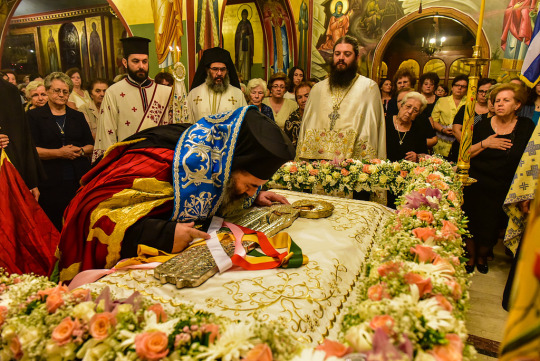

23. The Catching of the Cross
On the sixth of January, the Christmas holidays in Greece officially come to an end with the ‘festival of light’ (‘ton foton’ in Greek), also known as Epiphany.
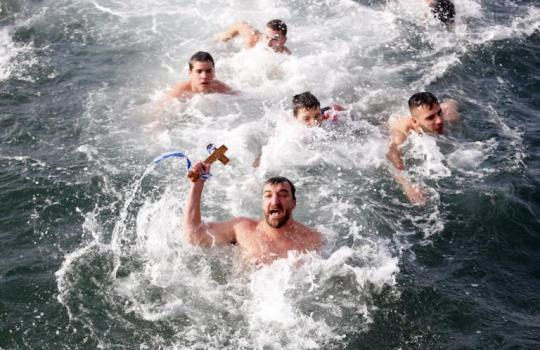
In the Greek Orthodox Church, Epiphany is celebrated as the revelation of Christ as the messiah and second person of the trinity, at his baptism, by John the Baptist, in the River Jordan.
Another cause for celebration in the Greek Orthodox Church on this day is that Christ’s baptism was only one of two occasions when all three persons of the trinity revealed themselves, at the same time, to humanity:
God the Father, speaking from the clouds, God the Son, being baptized in the River Jordan, and God the Holy Spirit, revealed as a dove, descending from heaven.
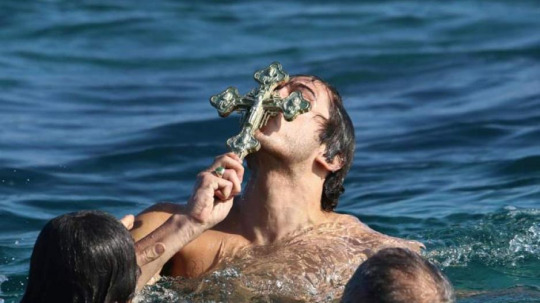
On Epiphany, the Greek Orthodox Church performs
the ‘Great Blessing of the Waters’.
This ceremony is usually performed twice, once on the eve of Epiphany which is performed in the church, and then again on the actual day outdoors with priests blessing large bodies of water, sea, rivers, lakes etc.
The tradition is that
a priest, surrounded by brave young men and boys, throws a cross into the sea, either from the harbour or from a boat at sea; the minute the cross leaves the priest’s hand, the divers jump into the freezing water to catch the cross. The lucky one who finds and returns the cross is blessed by the priest. As the cross is victoriously brought back, the priest releases a white dove, as a symbol of the holy spirit.
This tradition is carried out to commemorate the baptism of Christ and to bless the waters.
24. More customs
Each city, town and village is protected by a different saint. When the saint of the area celebrates a fair is organized. There is music, dance and stalls where the peddlers sell their merchandise.

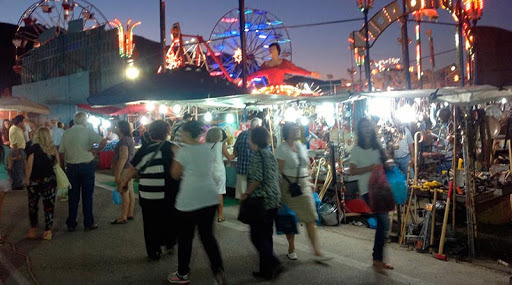
But Greeks know that some of their customs are not approved by the church. We do it anyways and sometimes the priests join, too!
Το celebrate the Epiphany and chase away the evil spirits some residents dress up in scary attire and make a lot of noise with their voice and bells. They drink excessively, they dance and even fight with each other “to the death“ (it’s fake, don’t worry!). This custom exists in many areas of Greece, from Thrace to Cyprus. Even though the people who dress up have many names - momogeroi, babougera, ragoutsia etc - they all symbolize the carefree spirit, childish fun and trickery. Don’t get in their way because they will chase you though the village!

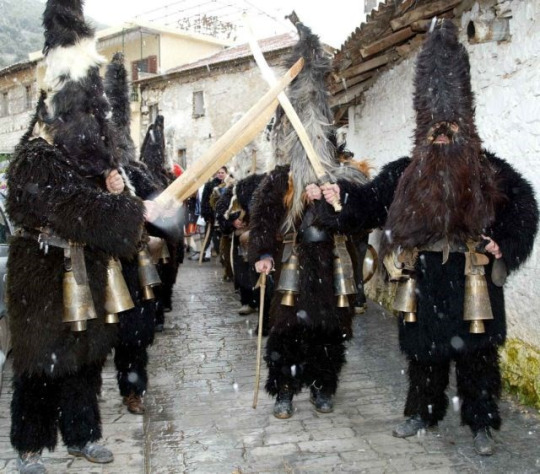
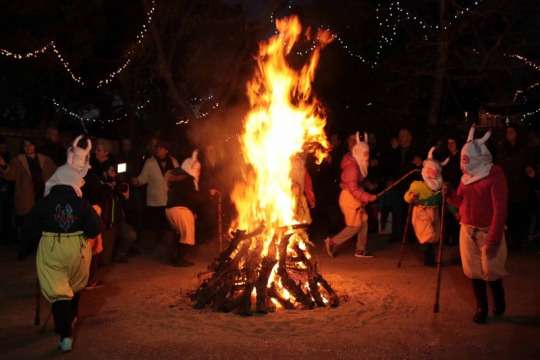
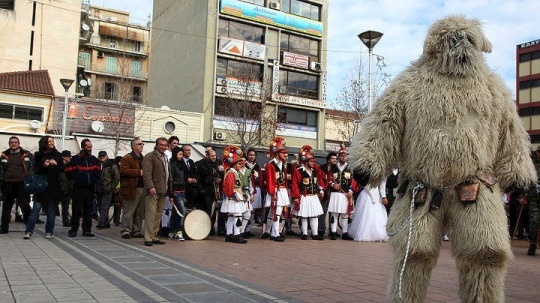
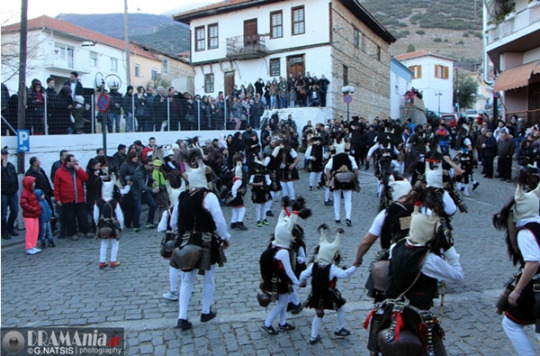

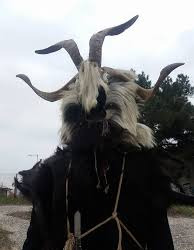
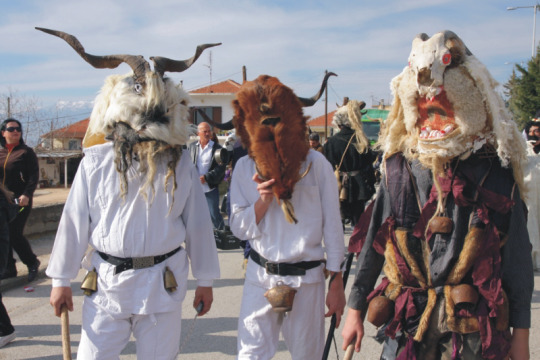

In these festivals there are different characters like the bride, the devil, the cop etc, who can symbolize fertility, the New Year, the Old Year and other concepts.


Sometimes the bride (usually played by a man) is abducted and it’s said to be a remnant of a re-enactment of the abduction of the goddess Persephone by Hades.
In other areas the Dionysiac character of the festival is eccentuated by the presence of a man who pretends ot be the god of wine, vegetation, happiness, Dionysos.

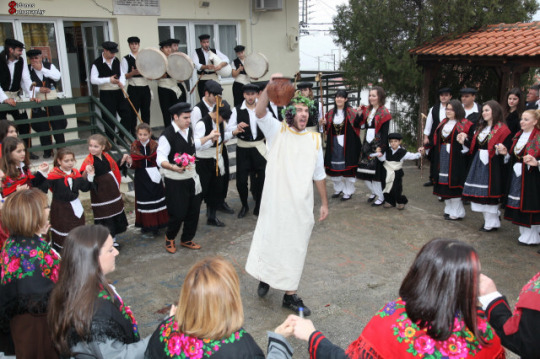
In some areas there is also dancing around a gaitanaki!
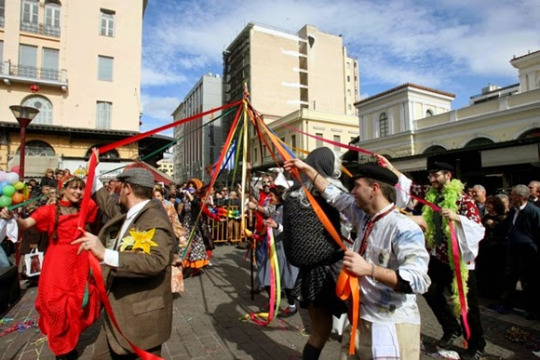
In some areas a fake camel (three people under a cloth) is presented on the streets. It probably started as a spectacle for kids but in some cases today it’s a symbol of resilience and patience. It can also remind us of the magi who rode camels to visit baby Jesus.
There is also the story where a Greek woman is abducted by a Turk and three young men pretend to be a camel to enter the Turk’s wedding with her and steal her back! (Something like the Trojan Horse!)

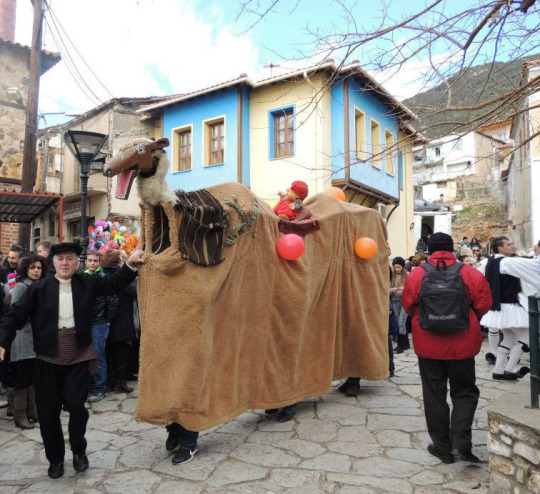
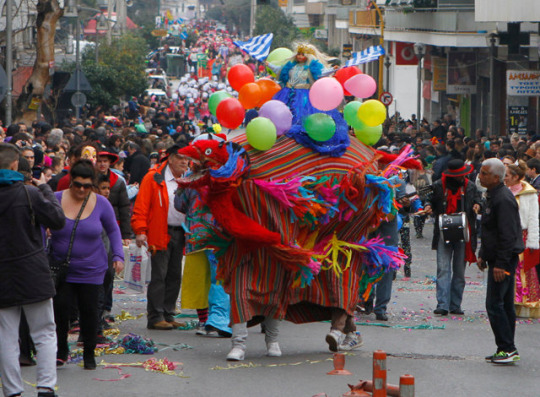
25. Random Information
Namedays are the days when the saint who has your name died. It's said that you actually take your name from them - even if it comes from your grandparents the saint is the reason you have it.
In that day you bring treats to your school or work, or you treat your friends to drinks or coffee. People give you wishes ("enjoy your name" is the most common) and they call you on the phone to wish if they are away. The most common name in Greece is Maria and in Maria’s nameday everybody has to call half of their relatives and friends to wish. It’s a bit offensive if someone doesn’t remember your nameday or if they don’t call.
We bring food to the workplace in happy events - like when your child was accepted into a university.
Lots of people cross themselves when they pass outside a church. They could be passing on foot, on the bus, or even when they drive a motorcycle.
You also cross yourself when you call god for protection or when you hear something strange (accompanied with "come Christ and Virgin Mary!")
Making embroidery with the face of Jesus and/or Virgin Mary is a thing.
40 days after the pregnancy women and their newborns can
woman can go out of the house but they have to go to Church to be blessed by a priest first.
We say "Christ!" when a person is chocked and "Small healths!" when someone is sneezing.
When a baby is yawning bad spirits could come in so we cross their mouth. We also give them eye bendants so the Evil Eye won't get to them. People spit (just saying "ftou ftou ftou") the child after saying good words for them so they can protect them from others who will flatter them with malice. The Evil Eye is recognised by the Church. See more in my #mati tag.
Bell ringing every day before the morning and evening liturgy. It also chimes every hour. On Good Friday it rings solemnly all day.
Priests are considered spiritual leaders by many in the sense they can listen to you and guide you like a psychologist. "My spiritual" people call them.
You don't have to have your mind unguarded, that's why Greek orthodoxy is against yoga which teaches the emptying of mind
Mondays and Wednesdays of all year are for fasting - just meaning you don't eat meat. Some people also fast sexually on those days.
Hatzis- (from middle eastern "hajj") is for people visiting the holy land (Israel) on pilgrimage.
The icons of saints you buy have to be blessed by the Church before you hang them, so they can offer you a connection to the divine.
Every day at school children gather in the yard and one child says the Lord’s Prayer
We don't know the hymns by heart. They are too many and long. But there are books you can read and older people (usually women) usually study them.
All the saints in hagiographies look kinda malnourished because they are supposed to avoid the earthly pleasures.
We give epithets to the saints according to their characteristics - like we did with our ancient gods.
Lots of saints probably “covered” the dominions of older deities because Greeks were used to having smaller powerful entities for different stuff (there is even a saint who helps you find stuff if you dedicate a pie to the church)
We have a set of explanations for dreams (Ονειροκρίτης). For example, if you see something very good in your sleep about a person, misfortune will find them. If you see them dying, they will live for many years.
We read the future in the bottom of the cup of Greek coffee.
From the Byzantine era and today people buy holy wood - from the cross of Christ they say - and bones of saints. In the old time those were also used for witchcraft.If you are born on a Saturday you don't see creatures or ghosts. Also people born on Saturday are lucky and whatever they wish comes true.
Dick festivals are a thing in some areas and they mostly happen on Greek Carnival. Traditional sex songs with dances are also a thing.
Virgin Mary is the mother of Greece, and you see her as a mermaid even. We are pretty chill with our divine figures - we use them in swearing a lot, too.
Many people cross themselves before and after eating.
We take oil blessed from the Church and we put it in the lamps of our home altars. We also anoint people who want to keep safe with it. (My grandma made a cross in my forehead, for example). Many take it home the myrrh produced by the bodies of saints.
We place a bone of a saint on the ground where a church is going to be built.
Sometimes we call a priest to bless our new vehicle!


Also, it’s not a very safe practice but a lot of people hand crosses and icons from their front mirror.
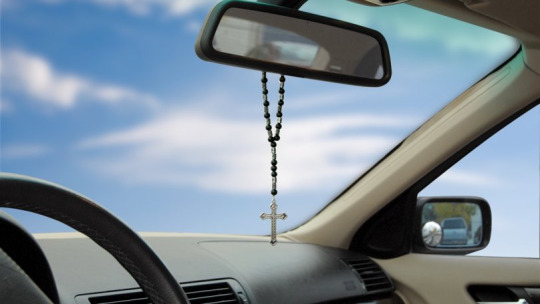
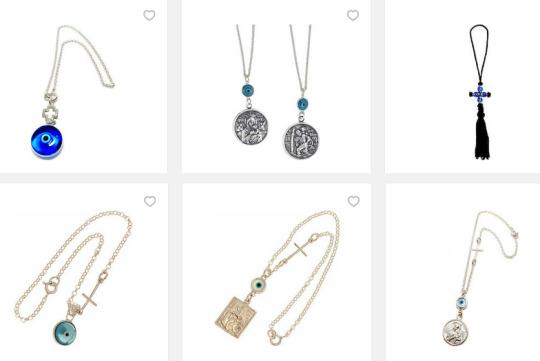
Notice that the #mati is also there!
34 notes
·
View notes
Text
02/06/2019 DAB Transcript
Exodus 23:14-25:40, Matthew 24:29-51, Psalms 30:1-12, Proverbs 7:24-27
Today is the 6th day of February. Welcome to the Daily Audio Bible. I am Brian. It is great to be here with you today as we take our next step forward into this month and through the Bible. And we’ve been reading from the Amplified Bible this week, which is what we’ll continue to do. We’re in the book of Exodus in our Old Testament reading. Today we'll read chapter 23 verse 14 through 25 verse 40. And we’re reading some of the first laws to be given.
Commentary:
Okay. So, in the book of Matthew today Jesus is continuing a conversation that He started yesterday as He’s walking with His disciples by the Temple complex and they're kind of marveling about the construction of the whole thing and Jesus says, “the whole thing’s coming down” basically and then He begins this conversation about the end times. So, He’s like, “the sun will be darkened and the moon isn’t gonna have any light and the stars are gonna fall from the sky and the powers of the heavens are gonna be shaken and then at last the sign that the Son of Man is coming will appear in the heavens and there’ll be deep mourning among the peoples of the earth.” This is Jesus actually quoting Isaiah chapter 13 and Joel chapter 2 as He's discussing the time of the end. And as we talked about yesterday when we began this conversation, Jesus is…He's revealing that the thing that we deeply long for, right, the rebirth of everything, when all things are made new. So, what we long for is preceded by things that we'd probably rather skip, right? We want the baby without the labor pains but it's only the labor pains that bring the new birth. So, for millennia we’ve been trying to, you know, observe the signs of the times and make the predictions on where we are, and an apocalyptic worldview kind of leaves a sense of unease just kind of permeating everything, but Jesus actually pulled us away from that fear and hysteria and asked us to look from a different perspective. Jesus said, “nobody knows the day or the hour when these things will happen, not even the angels in heaven, not even the Son Himself. Only the Father knows. So, see you gotta keep watch because you don't know the day when your Lord is coming.” That could change our lives if we would embrace that because it involves every moment of our lives starting like right now. So, Jesus said, “yeah, I mean it’s gonna get rocky out there and there's going to be some tumultuous situations to go through but we’re not supposed to be pulled toward fear or panic, instead we’re supposed to live with awareness and hope, awareness of what's going on so that were not blindsided and surprised and hope for what is actually happening. Even though at first it’s gonna look hard and bad, it's actually birth pains, new life comes out the other side of this story.” And we aren’t gonna figure out…we’re not gonna figure out something in Jesus Himself from His own lips is claiming not to know. What we’re supposed to do is be ready, be prepared, is the whole story that Jesus told, the last of our reading today where a master has put a servant in charge of caring for the other servants and then goes away, and he expects that servant to care for his other servants until he gets back. And if he does then the master will put them in charge of all his possessions but if he doesn't and he says in his heart, and this is where it gets a really, really familiar, “it's taking a long time, he's not going to return for a long while.” If the servant in the story takes that perspective, then he will stop being vigilant about how he cares for the other servants and may even begin to be abusive toward them and may begin to be seduced into what…in Jesus vernacular, “drink with drunkards”, right? So, be seduced into a worldly lifestyle that's full of partying and no vigilance, well then, the servant wasn't paying attention, wasn't aware, and the master will show up unexpected. So, basically the posture Jesus is suggesting that we espouse and live into is to approach…is to approach the future as if it's already underway. And if we’ll heed this then we will be ready, not just like for whenever the end times may be truly upon the human race we’ll be ready to participate and collaborate with God in the redemption of the world wherever we are on the continuum. And watch as I tell you this, these themes of vigilance, of awareness of endurance, and stamina, preparedness, they're gonna run through the rest of the whole Bible. The Bible will continually shake us awake because we’re not supposed to go through life asleep, we’re supposed to be participating.
Prayer:
Father, we thank You for this, another day to kind of contemplate these things, these matters of vigilance and preparedness in the context of the end times, which is what You were speaking of today Jesus. And, so, we thank You for this opportunity and we invite Your Holy Spirit to begin to speak to us about what it looks like to be ready and prepared, what it looks like to live as if the coming of the kingdom is underway, is happening, is now, and is moving forward, and we are a part of the story. Come Holy Spirit we pray in the mighty name of Jesus we ask. Amen.
Announcements:
dailyaudiobible.com is the website, its home base, of course, where you find out what’s going on around here. So, stay connected in any way that you that you want to.
The Prayer Wall is dailyaudiobible.com as well. So, pray for your brothers and sisters or maybe you need your brothers and sisters to pray for you. This is one good way to reach out. So, check that out. The Prayer Wall is at dailyaudiobible.com. But it's also…you can also access it from within the Daily Audio Bible app by pressing the little drawer icon in the upper left-hand corner of the app. So, stay connected and pray for each other.
The Daily Audio Bible shop is also available with resources for this one-year journey through the Bible. So, check that out. You can check that out in the app or on the website as well.
If you want to partner with the Daily Audio Bible, you can do that at dailyaudiobible.com. There is a link that is on the homepage. If you're using the app, you can press the Give button in the upper right-hand corner or, if you prefer, the mailing address is PO Box 1996 Spring Hill Tennessee 37174.
And if you have a prayer request or comment, and I have a prayer request, I mentioned it yesterday, that we as a community begin to pray into and over our pilgrimage to the land of the Bible that's coming up in just under two weeks. We’ll be heading out and certainly I the team will be heading out from here but people from all over the United States and even the world will be flying in and meeting up in Tel Aviv and off we will go. So, prayers of the community over that as we go into it, as we’re there, and as we reintegrate back into our lives wherever our homes might be. This is something that needs prayer, needs a lot of prayer, needs God's people who are in this together, which is us, this community around this global campfire in this together. So, thank you for your prayers. But if you have stuff going on in your own life there are a number of numbers that you can call depending on where you are in the world. If you're in the Americas, 877-942-4253 is the number to dial. If you are in the UK or Europe 44-20-3608-8078 is the number or if you are in Australia or the lands down under 61-3-8820-5459 is the number to dial.
And that's it for today. I'm Brian I love you and I'll be waiting for you here tomorrow.
Community Prayer and Praise:
Hi Daily Audio Bible, my name is Mary Ann Wilson. I’m from the New Brunswick Canada and this is my very first call. I started listening back in November and I will hopefully get to know you a little bit better over the coming months, but right now I just want to lift up our sister Margo from Australia who’s now doing her missionary trip in Liberia. Margo you been on my heart the last two weeks at least and I’ve been prompted to call more than a dozen times. I have avoided it so I apologize. I ask you to forgive me. So, heavenly Father I just lift up our sister right out. Father, she knows that she’s obeying Your call. Father, she wants nothing more than to be in Your will. And, so Father, I praise You, the god and Father of our Lord Jesus Christ, the Father of compassion and the God of all comfort. Father, we pray for comfort for Margo right now so that she as she is comforted she can then comfort others with the same comfort Jesus has given her. This Lord is what she’s been called to. Father give her peace, Father give her joy again. Lord, Your joy doesn’t leave us, sometimes we leave it. And, so, Father we just pray that Margo would grasp onto You and reach out to You. Also, Lord, I just thank You for Prodigal. I’m so glad to hear his voice again and that he’s doing better, not good but better. Father, thank you, I lift him up in Your heavenly precious arms. In Jesus’ name. Amen.
Hey everybody it’s Margo from Australia still currently in the UK. Just thought I’d check in and let you guys know that I am doing better, certainly doing a lot better and I am incredibly grateful for all of your prayers. I have felt them. I really…those first few days I think I kinda just went into shock and, yeah, they were rough, but I’ve regrouped. I am feeling the peace of the Lord. I still have my ups and downs. Obviously, it’s not gonna change but I have His piece in my heart and I certainly have excitement for the future. I do want to thank a few people that specifically prayed. Valerie prayed. That day you prayed was perfect timing. And Paul from Houston, you prayed a couple of prayers that were so meaningful. Candace from Oregon, I’m so grateful for that beautiful prayer you prayed. And Amazed by Brace in Massachusetts, you said you were praying and that means so much to me. Sherry who loves to worship, that praise you prayed brought tears to my eyes. There was a man on the prayer line, I don’t think he left his name, he prayed for us and then yesterday Isabel from Australia prayed. And it is so encouraging to know that people are praying for me and my husband and understand that this is a really hard time, you know, it’s exciting, but it’s also hard and I’m so grateful for your prayers. We have…my last day today of our orientation course that we’re doing here in the UK and tomorrow we leave for Uganda. So, my husband will be doing some flying stuff there and getting his African licenses all sorted out. So, I would love it if you’d continue that that process could go quickly because we’re really keen to get to Liberia and these things can sometimes take while in African countries. Okay, I love you all heaps…
Good day everyone, this is Pamela the teacher/pastor’s wife calling from Huntington New York. I hope everyone is having a fantastic beginning of the new year. I miss all of you, haven’t had an opportunity to call in like I would like but always listening and always praying. Today I just want a lift up pastors and their wives and their families. Father, in Jesus’ name we lift up pastors, we lift up the men and women of God that stand in __. We pray for them oh God that You would give them wisdom, that You would give them knowledge, that You would give them direction. We pray for their wives as they stand with them in faith oh God that You would strengthen them and encourage them. We pray for their finances. Oftentimes Lord You know the things that have to be made with pastors and their families. We pray Lord God that You would bless their finances open up doors and make ways Father. We just thank You for their children. Oh God who also make sacrifices with their parents Lord. We lift them up God. Oh God we thank You for blessing them, we thank You for using them for Your mighty glory Father in Jesus’ name. Continue to pray everyone, for those who pray can expect a miracle. And we ask one special prayer request, lift up pastor Gary, that God will have His way in his life in Jesus name. Have a wonderful day everybody. Bye.
Morning Daily Audio DABbers. About a year ago I found this app and I was listening and I missed the whole first part of the year where Brian goes in depth into the Bibles and what we do and how we do it. So, I was just listening to the __ part. I didn’t know about the requests. It wasn’t until, I believe it was Candace from Oregon, made a statement one day that stayed with me the entire year. She said, “you have no idea.” And I was a little bit offended at that thinking, “well yeah, I do…it’s an audio Bible app.” She was correct. I felt the Lord saying, “be still.” And so, I often pose a be still on my lips. Thank you, Lord. I’ve grown so much through this year and I just wanted to share those that are joining us to this year, you have no idea what the Lord has in store for you. Keep with it. I encourage you to go. All my friends Blind Tony, Victoria Soldier, I have learned to love you through this app. I continue to listen every day. My heart is full as Brian, you and your family have such a wonderful ministry. This __ healing in parts and ways you have no idea. Thank you.
2 notes
·
View notes
Text
A Bear Returns to Brooklyn (Post 122) 12-30-15
It was a Christmas where I thought about keepsakes and their value quite a bit. I guess my understanding of keepsakes has formed that something is really a keepsake only when its personal value exceeds its monetary value by a factor of ten. For instance, the keepsake that reminds me most of my grandfather is a sales trophy that he won years ago selling Electrolux vacuum cleaners door-to-door in Boston. He never gave me the trophy, it was in my parents’ house and it was not displayed prominently … with pretty thorough justification. The statue is in the shape a gilded man like and Oscar with arms extended on high as if he is displaying a heavy weight champion belt, except he is holding a vacuum, one of the old-fashioned kinds that you pulled along behind you until eventually the plug pulled out of the wall.

Certainly the trophy is saleable; I have watched enough episodes of American Pickers to know that there is a market for oddball relics of the prosperity boom of the 50’s, but I won’t be packing it off to Dayton, Ohio or wherever Antiques Roadshow holds their next swap meet disguised as a soiree. I know I am not depriving Natalie of a year’s tuition to Notre Dame or Ohio State, by keeping the statue. It means more to me than the $20 that Mike Wolfe or Frank Fritz would offer due to its outstanding funkiness monetized. Nor will the statue ever probably bask in the soft glow of a recessed spotlight as the centerpiece of my mantle, but neither will it languish in a box in the attic. Each time I spy the Electrolux Oscar as he resides like a gargoyle on a bookcase above my desk, I will think of my grandfather fishing with me on his dock in Winter Harbor on Lake Winnipesauke in New Hampshire. In my mind I consider the statue to be a major award, more modestly displayed than the ill-fated leg lamp in A Christmas Story.
My few keepsakes and their importance to me made the bear in the basement a problem to my conscience like the buried pulmonary organ in Poe’s story The Telltale Heart. The keepsake bear has no place of suitable prominence in my home currently with nothing promising in the near future either. I don’t have a lot of places to display a large-sized stuffed animal that was probably very special to my wife, but about which I had no knowledge whatsoever. He isn’t a giant grizzly by any means. Overall he is about the size of Natalie’s American Girl doll. The most obvious and easiest cop-out solution would have been to add the bear to Natalie’s bounteous collection of stuffed critters. She offered to house him several times, but her room is already near bursting with curios. Natalie could outfit an entire battalion with various pellet filled frogs, over-stuffed ursine playthings and dolls or all sorts. All of them are named and cherished, but they are legion. This bear had been particularly loved by Pam and he didn’t seem to deserve second-teamer status, like Kobe Bryant as an eighth man.
The bear had all the signs of being special to a kid, despite the fact that Pam never told me his name or relayed anything about his origin and history. The bear had a tag that identified him as a Knickerbocker product. That the tag was still affixed was truly wondrous because the bear was well worn. His pelt was looking pretty spotty; he would have been a good candidate for a fur club purveying whatever treatment the Donald or Joe Biden have procured for their cranial rugs. On the whole, though, that wasn’t the big problem. The bear looked to have suffered what they termed in the navy as a sucking chest wound. His back left side rib cage had been kind of blasted to shreds by shotgun so that the best emergency treatment option would have been wrapping him in Saran-wrap or a plastic bag to continue minimal lung function until a corpsman or a priest arrives to provide a better solution.
Anyway, no sheet of cellophane was necessary for the bear, as he had been sewn back together by a seamstress of rudimentary skill that could only have been a ten year old Pam. A dog must have gotten a hold of Pam’s treasured toy at one time or another, which is exactly the dilemma I worried about if we brought him up into the house. The bear was safe from dog attack in his plastic container residence in the basement utility room, but he might as well have been in a stuffed animal morgue. I do keep some keepsakes for the kids there that I don’t feel are necessary to display continuously: Wonder Woman lunch boxes, school memorabilia, souvenirs from long ago trips and old clothes that were once favorites. The bear, on the other hand, had been a first teamer of some sort. Each of my children has had a special stuffed animal, but never have I seen one as worn out as this bear. There had been a lot of love poured into this particular keepsake, by a very special person to all of us.
Pamela bear is the only keepsake that I would put in a higher class. She is Natalie’s bear, but only by inheritance. With Pam home under hospice care at her last Valentine’s Day, I bought her a pink bear that smelled like the chocolate that she loved but could no longer eat. Short of items to give to a six-year-old girl at the passing of her mother two days later, I gave Natalie the pink bear that had sat in bed with her mother as she slept her last few hours away before leaving us for a better place. Pamela bear has been Natalie’ constant bed companion ever since and it shows. The bear in the basement had been loved on the same level.
In the weeks after Pam’s death, I sent a few things to her sisters that I thought they might have wanted. A carving of her name and a Garfield doll that all of our children had tried to steal from Pam at one time or another. Pam was an eldest child and considered here stuff to be her stuff, so I always imagined that her sisters probably had an eye out for Garfield as well. I imagine that the little stuffed animal sits somewhere special in Pam’s sister Annette’s house where it catches her eye occasionally and reminds Annette of her sister Pam at the age when they grew up together. For so much of their adults lives the sisters were separated by miles and commitments that didn’t exist in their little four bedroom house in Brooklyn, Maryland where they had just been close family, not far-flung siblings.
I guess that connection through time was what finally convinced me that the bear should travel back to Maryland to Pam’s other sister Stephanie. So I packed him up last Saturday along with Natalie’s, Stephen’s and my overnight bags for the six hour pilgrimage back to Kramme Avenue near the Annapolis snack bar where I first met Pam and began our life together. It seemed the right decision: either store the bear, risk the bear to Natalie and her doggies or return the bear to someone who would recognize him immediately.
As expected, Stephanie provided the name for the bear and stories about how an elder aunt had tried to separate Pam from her bear and blanket as officious adults sometimes do. Stephanie let me see her imitation of the scowling freeze stare that Pam used on any of her siblings that attempted to touch the bear, blanket, Garfield doll or any other possession of their eldest sister.
It is a pretty universal visage that I am sure my older brother used on me once upon a time. It interested me greatly that the bear’s name was the same one that my oldest boy called his own favorite bear that remains in its own plastic container in the utility room of my basement. I guess I will now consider the remaining animal who Walt Disney like awaits rediscovery to be Bear Bear Junior going forward. As for Bear Bear Sr., in my estimation, the decision to repatriate Pam’s bear to Maryland was the right one. I think Stephanie will cherish the keepsake because she has few reminders of Pam.
This ends my discussion of the Christmas of the Keepsakes. Some would chide me for even bringing up all this materialistic stuff in a column about Christian family life, but I don’t really see it that way. Although we are cautioned against collecting material possessions, I think that refers to more worldly items. In the Catholic faith images, relics and sacramentals are very important not because of their earthly value but because they draw our soul towards what they are spiritually connected to. Stephanie will not worship Mr. Bear Bear Sr, anymore than I worship my Electrolux trophy, and neither of us are likely to worship our family members that have the Pilgrim Church to assume their places in the Church Triumphant. It is helpful for us to think of them still because we all remain parts of the Body of Christ together. By keeping the trophy where I can see it, I maintain a stronger bond to my grandfather than I would otherwise hold. My pictures of Jesus and Mary work likewise.
#God#Jesus#The Holy Spirit#The Virgin Mary#grace#hope#love#faith#keepsakes#A Christmas Story#The Telltale Heart#bereavement#happiness#siblings#Christmas#relics#sacrementals#The Body of Christ
0 notes
Text
St. Francis Church
(Parish)
Built in 1951, this small attractive church is attached to an old people’s
home, near the hill of Mong-Ha.
The interior is simple and tranquil with a modernist black marble altar.
High louvred shutters along the walls open to pleasant courtyards and gardens.
Avenida Xavier Pireira
About Francis_of_Assisi
”’Saint Francis of Assisi”’ (born in Assisi, Italy, ca. 1182; died there
on October 3, 1226) founded the Franciscan Order or “Friars Minor”.
He is the patron saint of animals and the environment.
Boyhood and early manhoodBorn ”’Giovanni Bernardone”’, commonly known as
Francesco. His father, Pietro, was a wealthy cloth merchant. Of his mother,
Pica, little is known. Francis was one of several children.
The name of Francesco (“the French-man”), by which his baptismal
name was soon altogether replaced, has many conflicting explanations to its
origin. One claims it to have been given him soon after his birth by his father,
returning to Assisi from a trip to France; according to another account it was
due to his early acquisition of the French language (possibly because his mother
is believed to have been French). But perhaps the most probable explanation
comes from his infatuation with French literature, particularly with the Troubadors.
It is interesting to note the similarity between the lifestyle of the troubadors,
free of all worldly possessions, the antithesis of the life his father wanted
for him–and that which he would one day follow himself in his ministry.
Rebellious toward his father’s business and pursuit of wealth, Francis would
spend most of his youth lost in books (ironically his father’s wealth did afford
his son an excellent education, and he became fluent in reading several languages
including Latin). He was also known for drinking and enjoying the company of
his many friends, who were usually the sons of nobles. His displays of disillusionment
toward the world that surrounded him became evident fairly early, one of which
is shown in the story of the beggar. In this account, he found himself yet again
out having fun with his friends one day when a beggar came along and asked for
alms. While his friends ignored the beggar’s cries, Francis gave the man everything
he had in his pockets. His friends quickly chided and mocked him for his stupidity,
and when he got home, his father scolded him in a rage.
In 1201 he joined a military expedition against Perugia, was taken prisoner,
and spent a year as a captive. It is probable that his conversion to more serious
thoughts was a gradual process relating to this experience.
It is said that when he began to avoid the sports of his former companions,
and they asked him laughingly if he was thinking of marrying, he answered “Yes,
a fairer bride than any you have ever seen” – meaning his “lady poverty”,
as he afterward used to say.
He spent much time in lonely places, asking God for enlightenment. By degrees
he took to nursing the most repulsive victims in the lazar houses near Assisi.
After a pilgrimage to Rome, where he begged at the church doors for the poor,
he had a vision in which he heard a voice calling upon him to restore the Church
of God which had fallen into decay. He thought this to mean the ruined church
of St. Damian near Assisi and sold his horse together with some cloth from his
father’s store, giving the proceeds to the priest for this purpose.
Pietro, highly indignant, attempted to bring him to his senses, first with
threats and then with corporal chastisement. After a final interview in the
presence of the bishop, Francis renounced all expectations from his father,
laying aside even the garments received from him, and for a while was a homeless
wanderer in the hills around Assisi.
Returning to the town where he spent two years this time, he restored several
ruined churches, among them the little chapel of St. Mary of the Angels, just
outside the town, which later became his favorite abode.
The beginning of the BrotherhoodAt the end of this period (according to Jordanus,
in 1209), a sermon which he heard on the Gospel of Matthew 10:9, where Christ
tells his followers that they should go forth and proclaim that the kingdom
of heaven is upon them, and that they should take no money with them, that they
should take no walking stick for the road, and that they should wear no shoes
— made such an impression on him that he decided to devote himself wholly to
a life of apostolic poverty.
Clad in a rough garment, barefoot, and, after the Evangelical precept, without
staff or scrip, he began to preach repentance. He was soon joined by a prominent
fellow townsman, Bernardo di Quintavalle, who contributed all that he had to
the work, and by other companions, who are said to have reached the number of
eleven within a year, whom he called the “fratres minores”, in Latin,
“the little brothers”. The Franciscans are sometimes called Friars,
and this is a term derived from “fratres”, or “brothers”
in Latin.
The brothers lived in the deserted lazar house of Rivo Torto near Assisi;
but they spent much of their time traveling through the mountainous districts
of Umbria, always cheerful and full of songs, yet making a deep impression on
their hearers by their earnest exhortations.
Their life was extremely ascetic, though such practises were apparently not
prescribed by the first rule which Francis gave them (probably as early as 1209),
which seems to have been nothing more than a collection of Scriptural passages
emphasizing the duty of poverty.
In 1209 Francis led his followers to Rome and asked the Pope’s permission
to found a new religious order. In spite of the obvious similarity between Francis’
principles and the fundamental ideas of the followers of Peter Waldo whose similar
request had previously been rejected by the Pope, the brotherhood of Assisi
succeeded in gaining the approval of Pope Innocent III. The reason for this
unlikely approval is because after the Pope’s rejection of Waldo, his group
had paradoxically become more popular than ever. Realizing this, the Pope wished
to avoid repeating that mistake in an attempt to fight heresy, which had become
an increasing problem for the Church. Therefore, the Pope believed he could
prevent the spread of the Franciscans, or at least control it, by granting them
official recognition.
Many legends have clustered around the decisive audience of Francis with the
Pope. The account in Matthew of Paris, according to which the Pope originally
sent the shabby saint off to keep swine, and only recognized his real worth
by his ready obedience, has, in spite of its improbability, a certain historical
interest, since it shows the natural antipathy of the olderBenedictine monasticism
to the plebeian mendicant orders.
Work and extension of the BrotherhoodIt was not, however, a life of idle mendicancy
on which the brothers entered when they set out in 1210 with the papal approbation,
but one of diligent labor. Their work embraced devoted service in the abodes
of sickness and poverty, earnest preaching by both priests and lay brothers,
and missions in an ever widening circle, which finally included heretics and
muslims.
They came together every year at Pentecost in the little church of the Portiuncula
at Assisi, to report on their experiences and strengthen themselves for fresh
efforts.
There is considerable uncertainty as to the chronological and historical details
of the last fifteen years of the founder’s life.
But to these years belong the accounts of the origin of the first houses in
Perugia, Cortona, Pisa, Florence, and elsewhere (1211-1213); the first attempts
at a Muslim mission, in the sending of five brothers, soon to be martyrs, to
Morocco, as well as in a journey undertaken by Francis himself to Spain, from
which he was forced by illness to return without accomplishing his object; the
first settlements in the Spanish peninsula and in France; and the attempts,
unsuccessful at first, to gain a foothold in Germany. The alleged meeting of
Francis and St. Dominic in Rome at the time of the Fourth Council of the Lateran
(1215) belongs to the domain of legend; even Sabatier’s argument to show that
such a meeting actually took place in 1218 is open to serious objection.
Historical in the main are the accounts relating to the journey of Francis
to Egypt and Palestine, during the Fifth Crusade, where he attempted to convert
the Sultan Al-Kamil and gave fearless proofs of his readiness to suffer for
his faith; the internal discord, which he found existing in the order on his
return to Italy in 1220; the origin of his second and considerably enlarged
rule, which was replaced two years later by the final form, drawn up by Cardinal
Ugolino; and possibly the granting by Pope Honorius III (in 1223) of the Indulgence
of the Portiuncula – a document which Sabatier, who formerly rejected it, later
pronounced authentic.
The last yearsFrancis had to suffer from the dissensions just alluded to and
the transformation which they operated in the originally simple constitution
of the brotherhood, making it a regular order under strict supervision from
Rome.
Especially after Cardinal Ugolino had been assigned as protector of the order
by Honorius III – it is said, at Francis’ own request – he saw himself forced
further and further away from his original plan. Even the independent direction
of his brotherhood was, it seems, finally withdrawn from him; at least after
about 1223 it was practically in the hands of Brother Elias of Crotona, an ambitious
politician who seconded the attempts of the cardinal-protector to transform
the character of the order.
However, in the external successes of the brothers, as they were reported
at the yearly general chapters, there was much to encourage Francis. Caesarius
of Speyer, the first German provincial, a zealous advocate of the founder’s
strict principle of poverty, began in 1221 from Augsburg, with twenty-five companions,
to win for the order the land watered by the Rhine and the Danube; and a few
years later the Franciscan propaganda, starting from Cambridge, embraced the
principal towns of England.
But none of these cheering reports could wholly drive away from the mind of
Francis the gloom which covered his last years.
He spent much of his time in solitude, praying or singing praise to God for
his wonderful works. The canticle known as ”’Laudes creaturarum”’, with its
childlike invocations to Brother Sun, Sister Moon with the stars, Brother Wind,
Sister Water, Brother Fire, and finally Sister Death, to raise their voices
to the glory of God (influenced by The Prayer of Azariah and Song of the Three
Holy Children), dates from this period of his life.
The hermit stage which opened the career of many monastic founders was reserved
for the end of his who had once been so restless in his activity.
He spent the short remainder of his life partly on Monte Alverno on the upper
Arno, where he fasted forty days and longed for union with God, to be demonstrated
by the impression on his body of the wounds of Christ (see Stigmata); partly
at Rieti under medical treatment; and partly in his beloved Portiuncula at Assisi
waiting for his deliverance from the flesh. It is believed by some historians
that his last days drew huge crowds of people wanting to bask in his presence,
as well as those who awaited his death for the dividing up of his body for the
purpose of relics.
He died October 3, 1226, at Assisi, and was canonized two years later by Pope
Gregory IX, the former cardinal-protector of the order.
As patron saint of the environment
Legend has it that St. Francis preached to the birds and other creatures,
as well as preaching to humans. He is known today as the patron saint of animals
and the environment. His image is often placed in gardens in respect for his
interest in all things natural. His feast day is October 4.
The so-called ”’Prayer of Saint Francis”’ is a Christian prayer widely attributed
to the 13th-century saint Francis of Assisi, although it cannot be traced back
further than the 19th century.
Lord, make me an instrument of Thy peace;
where there is hatred, let me sow love;
where there is injury, pardon;
where there is doubt, faith;
where there is despair, hope;
where there is darkness, light;
and where there is sadness, joy.
O Divine Master,
grant that I may not so much seek to be consoled as to console;
to be understood, as to understand;
to be loved, as to love;
for it is in giving that we receive,
it is in pardoning that we are pardoned,
and it is in dying that we are born to eternal life.”
Amen.”
TOP
The post St. Francis Church appeared first on Macau Holiday.
0 notes